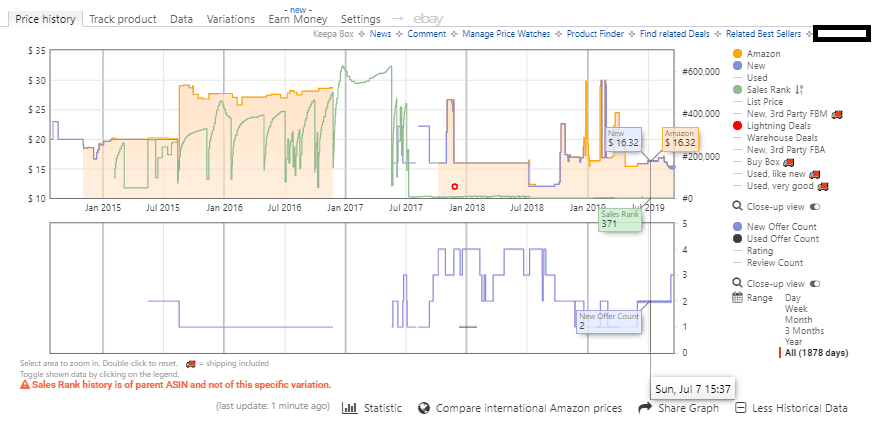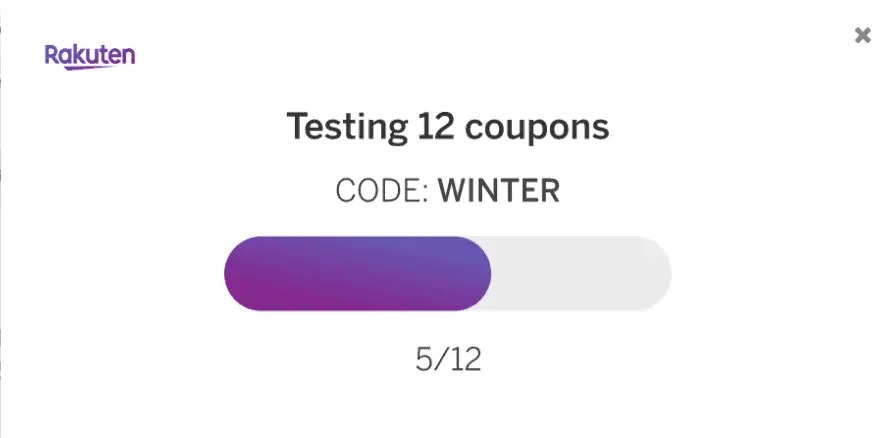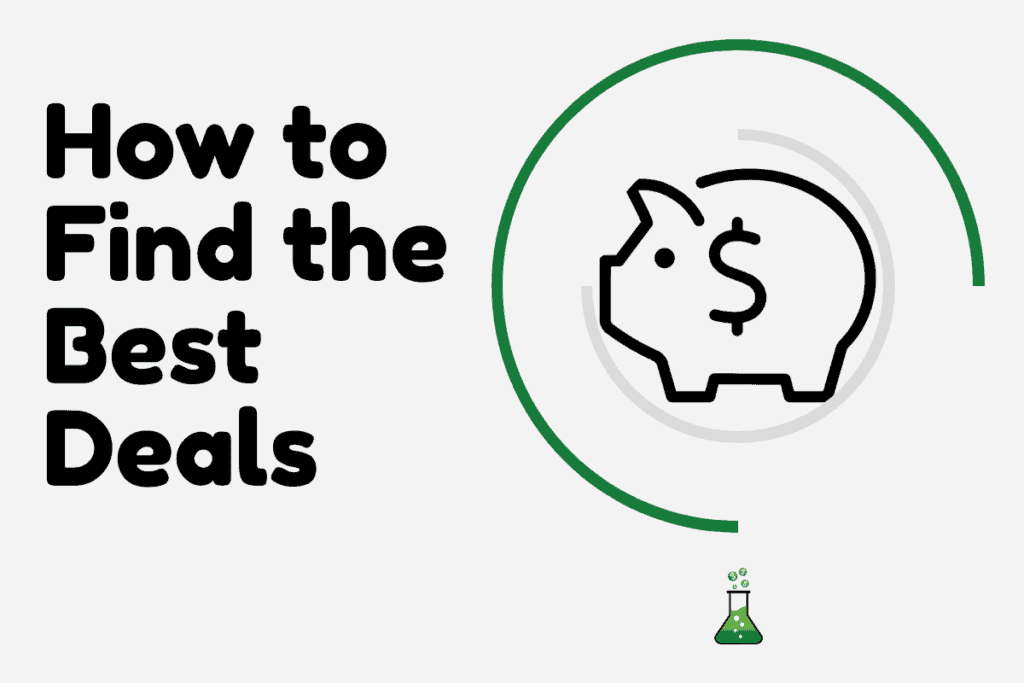One of the primary ways my business makes money is called arbitrage.
Arbitrage is buying low in one place and selling for more in another (usually on a marketplace like Amazon or Ebay). We’ve been doing this for over a decade and sell over 7 figures each year on Amazon alone just from arbitrage.
To say we’ve gotten good at finding good deals would be an understatement.
Below you will find our recommendations for getting the best possible price and strategies to help maximize your total savings.
Whether you are performing arbitrage, wondering how to find the best Black Friday deals, or just want to know how to find the best deal online at any time, these 12 tips will help you…
- Use price history checkers
- Use cashback sites
- Buy discounted gift cards
- Register to purchase tax-exempt
- Ship OA orders to prep center in a tax-free state
- Join store email lists
- Join store rewards programs
- Credit Card rewards
- Leverage price matching
- Test private or incognito browsers
- Test for exit intent offers
Sign up for the Arbitrage Finds leads list & BOLO group
When you sign up for our Arbitrage Finds leads list, we supply you with 100+ retail arbitrage leads every month. You also get access to our community BOLO group.

If you currently perform arbitrage or are looking to try, this is a great way to get more out of the time you have available for sourcing. We’ve had people earn thousands in profit thanks to a single lead we’ve sent out, and you’ll get 100+ a month.
From now until 3 PM ET on November 1, you can save 50% on your first month. On November 1, that deal will expire and an initiation fee of $99 will be applied for late enrollment during Q4. We run this list all year.
Use price history checkers.
Any experienced deal hunter knows that there are two types of deals. There are real deals where a product is offered at a price lower than you’d normally pay, and then there are “deals” where the store claims the price is discounted but it’s really still the same price you’d always pay.
The second type is frustrating, but it works because the majority of shoppers aren’t keeping track of what a product normally sells for or checking price history before buying. They just head to a store or website, see the big 40% off sign, and leave happy that they got the “deal”.
To combat this, we recommend using a price history checker to get an idea of what the product sells for over time. Two that we use and recommend are Keepa and CamelCamelCamel.

Keepa will put a price history chart on a products page on Amazon. CamelCamelCamel is useful when you are in a store and need to look up the price history from your phone. Both give you the history of the Amazon price only.
Google recently announced that they are launching a price history tool within their Google Shopping interface. We recently checked and were not able to use it, so it appears this isn’t available everywhere yet. This is worth keeping tabs on though as it would be a free way to get an idea of price history across multiple websites.
Use cashback sites.
Be honest, how many times have you found yourself on the checkout page, looking at the blank coupon or promo code box, and tried a few guesses?

Or maybe you’ve tried the old trick to Google “<site name> coupon”, only to regret having clicked on yet another expired coupon from one of those coupon sites. They say they’ve “been used 10+ times today”, but they never seem to work…
If you are familiar with these frustrations, you’re in luck – there are services that do all this for you.
Our favorite is called Rakuten (used to be ebates).
Rakuten is free and installs in your browser. When you are on a checkout page, it will automatically let you know if there are coupons or cash back opportunities. It will even let you know if the product is available for less money from another site.

It’s free, easy, and saves you money. Get Rakuten here.
Other options include BeFrugal and Honey. Both are free and work well. By using multiple, you can make sure you never miss a potential discount opportunity.
Buy discounted gift cards.
Buying discounted gift cards is an easy way to quickly save several percent or more on your purchases. There are many sites out there, and a site I like for seeing offers available through different suppliers is Gift Card Wiki.
The site we use most often and can confidently recommend is Raise, as we know that 100% of their gift cards are legitimate. We’ve never had a problem with them and use them regularly.
Another nice thing about Raise is that the vast majority of their gift cards are delivered electronically within a few minutes of ordering, and you can use them in store or online.
The amount you’ll save depends on when you are purchasing the gift card and what store it is for. Generally speaking, the more popular the store, the lower the discount you’ll see.

Register to purchase tax exempt.
Sales tax is a cost that can add up quickly on purchases. In most states you will pay around 7.5% in sales tax depending on the category of item. Sometimes there are ways to get this reimbursed on sales tax returns, but that can be a complicated and time consuming process.
Avoiding paying the sales tax in the first place is preferred. Any time when you are buying an item for resale, you technically don’t have to pay the sales tax on it. Not all stores will allow you to purchase tax exempt when you buy from them, but some do.
These stores that allow you to purchase tax exempt are where this tip comes in. Many large retailers have a relatively painless process that allows you to purchase tax exempt from them.
For example, here’s a link to Home Depot’s Tax Exempt purchasing application.
In terms of finding which stores you can register to purchase tax exempt online, Google is typically the best way to figure this out. And setting this up can save you a significant amount of money over time.
Send OA orders to a prep center in a tax free state.
As discussed in the above tip, not all stores will allow you to purchase tax exempt.
In these cases working with a prep center in a sales tax free state can help address this. A prep center is a company you send your online arbitrage orders to, and then the prep center takes care of shipping the items to FBA warehouses for you.
When you ship to a prep center located in a tax free state then you won’t pay any sales tax on the purchase!
In many cases the savings will more than pay for the cost of the prep for the item. For example, let’s say you are buying an item for $30 that sells for $60 on Amazon. Your state charges a 7% sales tax, so if you ship it to your address you will pay $2.10 in sales tax.
If instead you ship it to a prep center in a tax free state you will pay zero in sales tax, and likely around $1 for the cost of prep. This means you actually save $1.10 on the items that you send there!
If you need help finding a prep center, checkout our Amazon FBA Prep Center Directory.
Join store email lists.
Stores regularly send out coupons to subscribers on their email list, so this can be an easy way to save an extra 5 to 10% or more on an order.
If you are worried about getting more email, you can set up your email inbox to filter emails from certain senders to go straight to a separate folder. This can keep them from clogging up your main inbox, and you can also set it up so you won’t get notifications about them either.
But when you find yourself shopping at the store or website, you can go open the folder and see if there are any recent coupons to use.
Join store rewards programs.
Almost every store offers a rewards program. When you sign up for one, they will track your purchases and either offer cash back on purchases or send you extra coupons based on how much you spend.
These programs are free and an easy way to save extra money at the stores you shop at the most.
Take advantage of credit card rewards.
Using credit cards to pay for things can be a great way to save money as long as you get in the habit of paying your balance in full each month. This will prevent your balance from ever accruing any interest.
There are many “regular” credit cards that offer cash back on purchases regardless of where you shop, usually ranging from 1% to 5%.
The 3 cards we use most often in my business are the American Express Business Platinum, the Chase Ink card, and the Capital One Spark 2% cash back card. These earn a variety of different types of rewards that can be redeemed for travel and cash back.
Another option is to sign up for a store specific card. These can only be used at the store in question, but the discounts tend to be on the high side. For example, Target’s RedCard gets you an automatic 5% back.
Remember – any savings you enjoy will be quickly wiped out if you get in the habit of buying things you can’t actually pay for, so we strongly recommend setting up automatic payments that will pay your bill in full each month.
Leverage price matching.

Everyone knows about price matching, but it is still an often under utilized discount opportunity out there.
The vast majority of stores offer some sort of price matching policy, and some even offer to match the price PLUS give an extra discount. These can be used to your advantage.
When one store advertises an especially good price on an item, most customers will go to that store to buy the item. This can often lead to that item running out of stock quickly at the store that advertised the deal.
Other retailers who did not advertise a special on that product will often times be well stocked. This then allows you to match the price of the store offering the special to more easily find in stock inventory at the store you are price matching at.
Many stores will often price match Amazon.com as well. This can present opportunities to get inventory at the same price Amazon is selling at, but getting it immediately.
Spending a bit of time to learn stores price match policies can go a long way to getting some additional inventory at great prices.
Test a private or incognito window.

Some stores will offer different prices to people based on their viewing history. Sometimes this will work out in your favor and get you lower prices, but other times it will mean higher prices.
To test if a website is changing prices on you, use a private or incognito window so that the site can’t “see” your cookies and viewing history.
Test for exit-intent offers.
An exit-intent offer is something that is only displayed when a website visitor makes an action that displays an intent to leave the website. The main way this is done is by tracking the movement of the mouse pointer towards the top of the page.
Marketers know that once a visitor leaves a page, the chances of completing a purchase go down significantly. That’s why many people use tools to show an “exit intent popup” when you move your mouse towards the top of the page (near the URL bar and tabs).
All you have to do to test for this is to go to a sales page and move your mouse towards the top. (Towards the part of your browser used to close a tab or window is best.)
Note that if you are on a site you’ve been to a lot in the past, your browser may have a cookie that tells the site not to display an offer like this, especially if you’ve closed one before. So this is another situation where testing an incognito or private browser may help.
What is your favorite way to get a great deal?
We’ve shared the strategies we use, now it’s your turn. What is your process for making sure you get the best deal possible when shopping?
If you’ve found this useful, don’t forget to share!
And don’t forget to checkout the Arbitrage Finds group. Remember, the 50% off first month offer ends November 1 and an additional $99 initiation fee will apply for the rest of the year, so now is the time to join.

